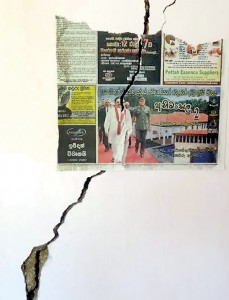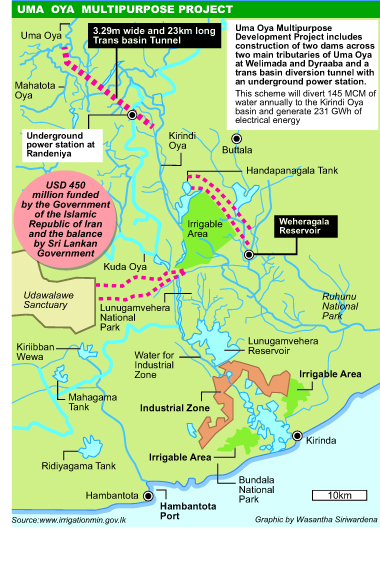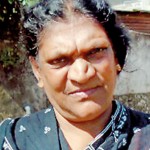News
Uma Oya project thumbs nose at the law
The absence of a government monitoring mechanism and disregard to rule of law have led to the Uma Oya project catastrophe.
The controversial Multipurpose Development Project which was suspended this week pending an independent impact assessment has not met any of the conditions outlined when approval by the Central Environmental Authority (CEA) was granted.

A third of the 15km tunnel is already completed. Pix by Nuwan Rajamanthri
Despite this the project is well underway with a third of a 15km tunnel already completed, according to Mahaweli Development and Environment Ministry secretary N. Rupasinghe
Haphazard implementation of the project has destroyed housing, water sources and livelihoods of more than 500 families living in Bandarawela.
An independent committee has been appointed that includes specialists from the National Building Research Organisation (NBRO), University of Peradeniya, Geological Survey and Mines Bureau (GSMB) to conduct a full assessment of the present status of the project, Mr. Rupasinghe said.
The project is financed partly through a $US450 loan from Iran with the Sri Lankan Government supplying the remainder. The project’s total costing is unclear.
Two dam walls respectively 30m and 45m high, will be thrown across the Dalgolla Oya and Mathatilla Oya, two main tributaries of the Uma Oya, at Puhulpola and Dyraaba, the Irrigation Ministry said.
The construction also includes a link tunnel of almost 4km between the reservoirs thus created at Puhulpola and Dyraaba reservoirs and a 15km headrace tunnel from the Dyraaba reservoir to a surge tank. There will be an underground powerhouse and a 3.3km tailrace tunnel.
Nearly 14 minor irrigation tanks are expected to be fed by the diverted water from the Uma Oya.

Cracks that have appeared on the walls of a home in the area
According to the Irrigation Ministry the scheme – if completed successfully – would divert 145MCM of water annually to the Kirindi Oya basin and generate 231GWh of electrical energy through the underground power station.
The CEA this week revealed that the project contractors had not met any of the conditions outlined when green light was given to the Uma Oya project.
Among the requirements was the condition to have officers from the GSMB present when drilling and blasting took place and to obtain necessary licences from them, CEA Chairman Prof. Lal Dharmasiri said.
Further, the contractor was to have proper dumping grounds for debris, obtain clearance from Wildlife Department on the impact to local fauna and flora, NBRO clearance to ensure no landslide threats were generated by the project and a proper plan on mitigating any negative social impact.
None of these conditions had been fulfilled.
The CEA has not conducted any reviews of the project to ensure that the conditions were met after it granted initial approval in 2011.
According to the Ministry of Power and Energy report “Performance 2014 and Programme 2015”, the contract was effective from 2010. The same report states that the project is to be completed by March 2015. If that is the case, CEA approval was granted only after the project officially commenced.
The Sunday Times has learned that the FARAB Energy and Water Project Company, the contractor of the Uma Oya project, filed for a licence from the GSMB only on 12 February 2015, four years after the project officially commenced.
The NBRO has never been consulted on the progress of the project.
On July 19, 2014, an Initial Environmental Plan was due to be presented to the CEA by the contractors but was not submitted. Following the failure to submit the report the CEA started initial investigations, Prof. Dharmasiri said.
“After the elections, when the authority managed to resume its work and I was appointed, we tookthe decision to immediately suspend the work until further assessment is done,” he explained.
The problems do not end there. Critics of the project have highlighted that the EIA covered only part one of the project. Part two, which includes the construction of a new tank, has not yet been assessed.
“The identified land is a 4000-acre forest area that is home to a lot of wildlife. The construction will disturb the wild life,” said Centre for Environment spokesman Hemantha Withanage.
Janatha Vimukthi Peramuna (JVP) Uva Provincial Council member Saman Withanage alleged that the project was launched only to fulfill political needs.
“The project was commenced to supply water to the Maththala Airport and other development projects in Hambantota. The ceremonial commencement of the project was in 2008 and the EIA for part one was approved only in 2011. The contractors had already started their preparation work by then,” he alleged.
Emphasising that the project had not addressed any of the conditions of the EIA for part one which warned of a negative impact to the Ravana Falls and intensification of elephant-human conflict, Mr. Withanage warned that matters would only get worse with part two of the project.
These allegations were denied by the contracting company FARAB Energy and Water Projects representative, Afshin Mostaajer Haghighi, Project Manager of Uma Oya Multipurpose Development Project.
| No light at the end of this dangerous tunnel By Nuwan Rajamanthri The Uma Oya multi-purpose development project is heading in one direction: doom, destruction and death for many, villagers with reliable local knowledge have affirmed. Residents say it is now clear that no proper study had been done on the topography of the Badulla area before the project began. They say that as a result of explosives used in constructing the tunnels of the project, about 175 houses around Bandarawela are showing large cracks, and at least 150 wells and many water springs have completely dried up.  Ven. Vanasirigama Siriratana Thera The Uma Oya project, worth $US450 million, was begun with Iranian aid to supply water to Hambantota. Reservoirs at Puhulpola and Dayaramba are to be constructed and linked to the Kirindi Oya, and water from the Uma Oya is to be diverted through a 15km tunnel. The construction of a hydro-electric power plant is also part of the plan. The various tunnels linked to the project runs through land that consists partially of thick, massive granite. Uma Oya project director, N.S.K.N. Silva, admitted that underground drilling and dynamiting of granite, carried out with heavy machinery and explosives, is affecting the earth’s surface. Villages such as Heel Oya, Makul Ella, Veheragala-thenna and Kurundugolla have already experienced the adverse effects of drilling and dynamiting. To date, more than 700 people are badly affected by the consequences of the construction work, with properties in these villages havingd suffered severe damage, according to the Disaster Management Centre.  Chitra Rajapakse Chitra Rajapakse, 63, of Heel Oya, said the well in her compound, more than 100 years old, had suddenly dried up on 26 December last year. Six other wells in the neighbourhood had also run dry, and Mrs. Rajapakse said residents were distraught because of this catastrophe. Farmer M.M. Jayaratne, 60, who also lives in Heel Oya, said apart from losing their only sources of water, residents are seeing huge cracks appearing in the walls of their houses and also along the ground, in areas where they grow paddy. The cracks and other damage were directly connected to the tunnel construction, W.M. Jayasundera of Puhulpola, Welimada said. “The engineers came and inspected our property. They admitted the cracks were being caused by the explosions through the granite but they will pay compensation only if there are more than 10 cracks.” He added dryly that one such crack alone made a house “worthless”. The Ven. Vanasirigama Siriratana Thera of Kurundugolla in Heel Oya corroborated the villagers’ claims, saying more than 150 wells had dried up on 26 December. Ven. Siriratana said other phenomena included cracks along the ground and also landslides. Wasantha Sanjeewa Somasiri, speaking on behalf of the affected villagers, thanked Bandarawela Divisional SecretaryE.M.S.B. Jayasundara for having taken steps on that ill-fated 26 December to distribute water and to inform all authorities. Mr. Somasiri said the Uma Oya project was a sheer waste of money. He explained that both the Badulla and the Hambantota districts had the same rain season. “When it rains in Badulla, it rains in Hambantota; when there’s drought in Badulla, there’s drought in Hambantota as well. So trying to carry water from here to there will inevitably be a doomed project,” he said. Mr. Somariri entreated the authorities to stop the project. “We should not worry about the money already spent. If the project continues there will be much graver dangers,” he said. “How can compensation be given for all the damage that is being done? Even the full amount of funds set apart for the whole Uma Oya project will not be sufficient to pay compensation.” Divisional Secretary Jayasundara said the officials of the Uma Oya project had agreed to provide drinking water to the villagers after the water supplies dried up. “They promised as much as 500 litres of water per family per day. The director of the project, N.S.K.N. Silva, also agreed to supply water tanks to families who do not have water tanks.” Badulla District Secretary Rohana Keerthi Dissanayake said the project engineers claimed the incidents described by the villagers were inevitable, happening anywhere in the world where tunnels such as this were being dug. “I have been informed that 60 per cent of the tunnel work has been accomplished now. However, they [the project authorities] admit that explosives used in the construction of the tunnel from Puhulpola to Dayaramba have been the cause of properties in many villages being damaged,” he said. “Consequently, at a meeting held between the affected villagers, Uma Oya officials and representatives of the Uva Provincial council, work on the Puhulpola- Dayaramba tunnel was suspended until discussions were arranged with President Maithripala Sirisena (who is also the Minister of Mahaweli Development and the Environment).” |

